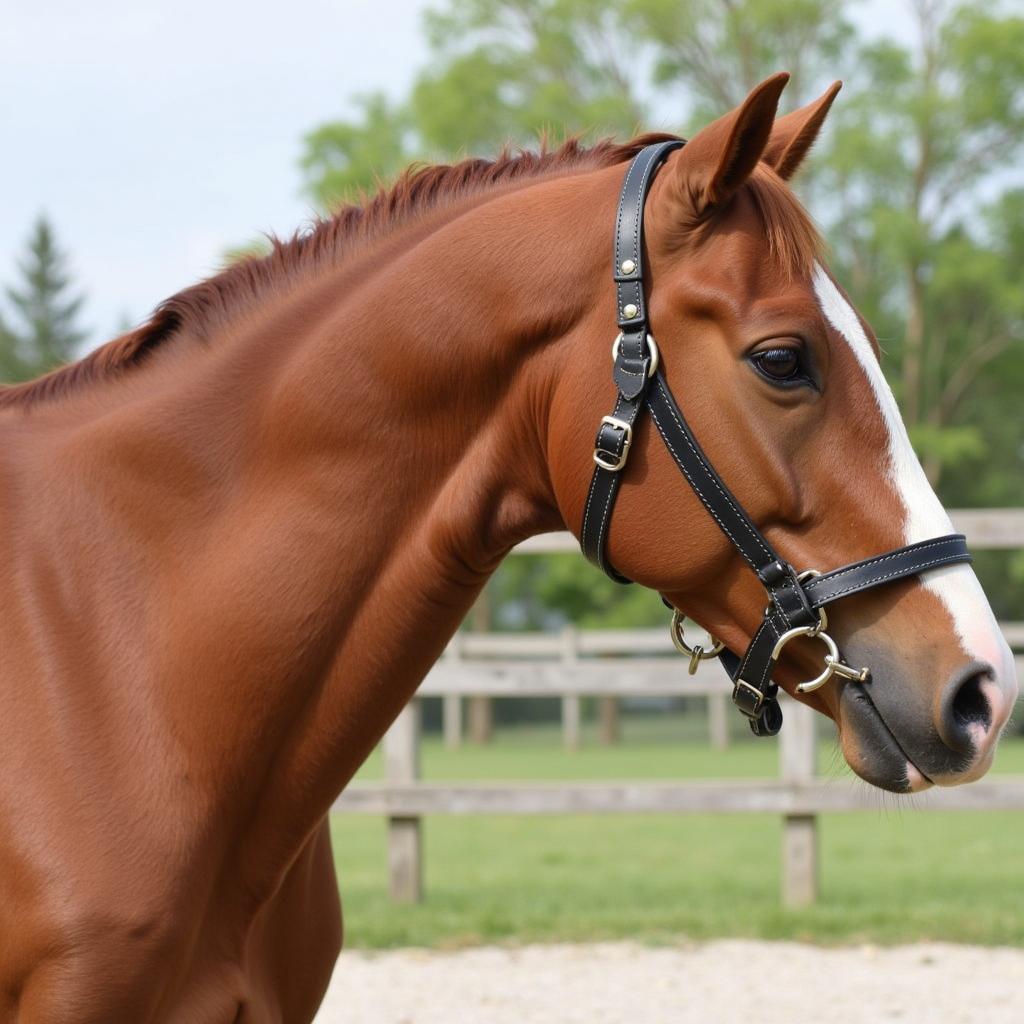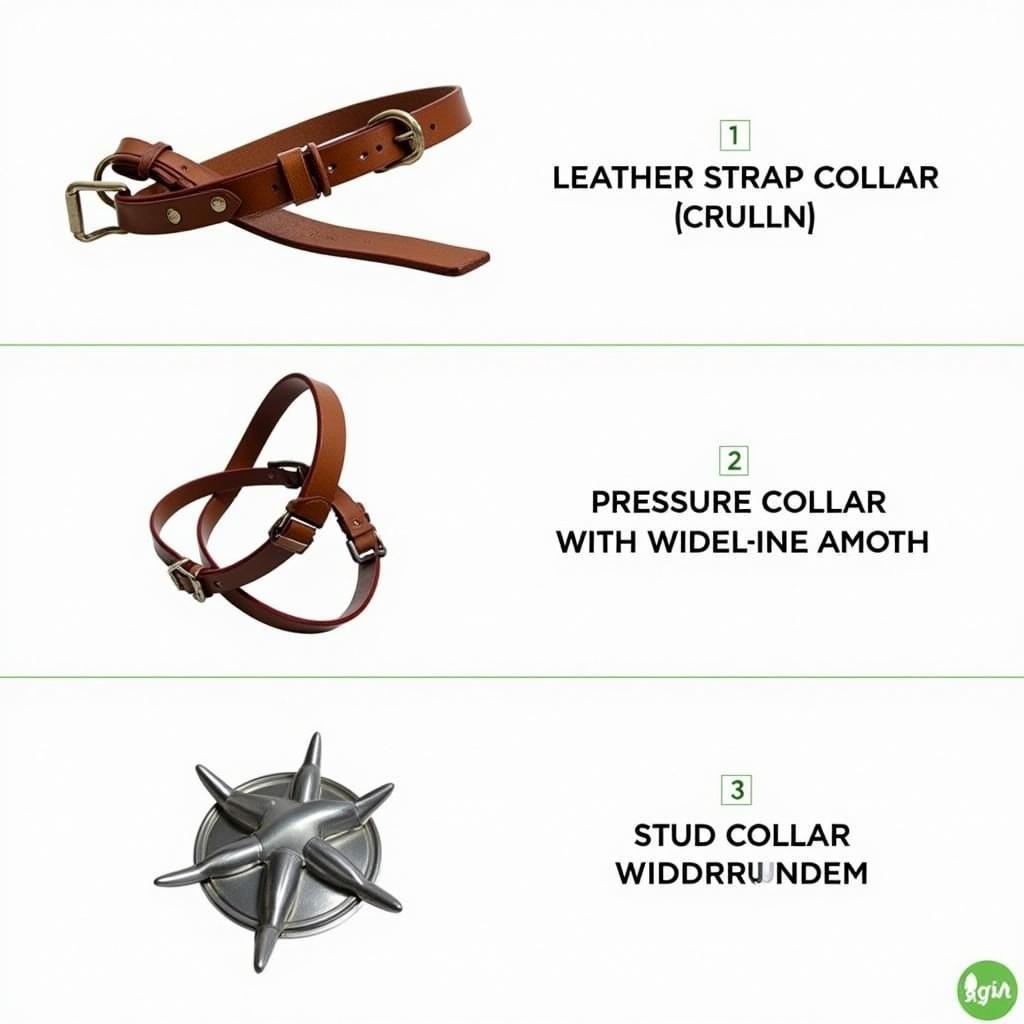A Cribbing Collar For Horses is a management tool used to deter a behavior known as cribbing. Cribbing, also called windsucking, is a stereotypy – a repetitive, seemingly purposeless behavior that some horses develop, often in response to stress, boredom, or underlying health issues. While it may seem harmless at first, cribbing can have detrimental effects on a horse’s dental health, digestive system, and overall well-being.
What is Cribbing in Horses?
Cribbing occurs when a horse bites down on a solid object, such as a fence post, stall door, or bucket, and arches its neck while swallowing air. This action often produces a characteristic grunting sound. While the exact reasons why horses crib are not fully understood, several factors are thought to contribute to the development of this behavior:
- Diet: High-concentrate diets and limited access to pasture can increase the risk of cribbing.
- Stress and Boredom: Horses are social animals that thrive on routine and mental stimulation. Confinement, lack of turnout, and insufficient social interaction can lead to stress and boredom, increasing the likelihood of developing stereotypies like cribbing.
- Genetic Predisposition: Some horses may be genetically predisposed to cribbing.
The Purpose of a Cribbing Collar
A cribbing collar is a humane device designed to discourage cribbing by making it more difficult or less satisfying for the horse to engage in the behavior. It typically consists of a strap that fits snugly around the horse’s upper neck, just below the poll.
 Cribbing Collar on Horse
Cribbing Collar on Horse
When the horse attempts to crib, the collar applies pressure to the throat latch area, making it uncomfortable to swallow air. The pressure is not intended to choke the horse but to create a deterrent that reduces the satisfaction associated with cribbing.
Types of Cribbing Collars for Horses
Several types of cribbing collars are available, each with its own design and mechanism of action:
- Strap Collars: These collars are usually made of leather or nylon and feature a single strap that tightens when the horse arches its neck to crib.
- Pressure Collars: These collars utilize a broader band or plate that distributes pressure more evenly across the throat latch area.
- Stud Collars: Stud collars have metal studs or bumps on the underside that press into the horse’s throat latch when they attempt to crib.
 Different Types of Cribbing Collars
Different Types of Cribbing Collars
Choosing the Right Cribbing Collar
Selecting the right cribbing collar for your horse is crucial for both effectiveness and their well-being. Consider these factors:
- Material: Choose a collar made from durable, easy-to-clean materials like leather or nylon.
- Fit: The collar should fit snugly but not too tightly. You should be able to comfortably fit two fingers between the collar and your horse’s skin.
- Horse’s Sensitivity: Some horses are more sensitive to pressure than others. Start with a milder collar and gradually progress to a firmer one if needed.
It’s essential to consult with your veterinarian or an equine behaviorist to determine if a cribbing collar is appropriate for your horse and to receive guidance on proper fitting and use.
Beyond the Collar: Addressing the Root Cause
While a cribbing collar can be a helpful management tool, it’s crucial to remember that it is not a cure for cribbing. To effectively address this behavior, it’s essential to identify and address the underlying causes:
- Dietary Changes: Provide your horse with ad-libitum access to forage, such as hay or pasture, and reduce the amount of grain in their diet.
- Environmental Enrichment: Increase turnout time, provide opportunities for social interaction with other horses, and offer toys or puzzles to provide mental stimulation.
- Veterinary Evaluation: Consult with your veterinarian to rule out any underlying medical conditions that could be contributing to the cribbing behavior.
Conclusion
Cribbing collars can be a valuable tool in managing cribbing in horses, helping to reduce the frequency and severity of this potentially harmful behavior. However, selecting the right collar, ensuring a proper fit, and addressing the underlying causes of cribbing are essential for the horse’s well-being. Remember that a cribbing collar should always be used in conjunction with other management strategies to provide a holistic approach to addressing this complex issue.
For personalized advice and support in choosing the right cribbing collar for your horse, don’t hesitate to contact us. We’re here to help you provide the best possible care for your equine companion. You can also check out our recommended cribbing horse collar selection on our website.
Frequently Asked Questions
Q: Can cribbing collars harm my horse?
A: When used correctly and fitted properly, cribbing collars are generally safe. However, an ill-fitting collar can cause discomfort, sores, and even breathing difficulties.
Q: Will a cribbing collar stop my horse from cribbing completely?
A: Cribbing collars deter cribbing but may not eliminate the behavior entirely. It’s essential to address the underlying causes for long-term success.
Q: Are there any alternatives to cribbing collars?
A: Yes, alternatives include dietary changes, environmental enrichment, and addressing any underlying medical conditions.
Q: How long will it take for a cribbing collar to work?
A: The effectiveness of a cribbing collar varies. Some horses may show improvement within days, while others might take longer to respond.
Q: Can I leave a cribbing collar on my horse all the time?
A: It’s not recommended to leave a cribbing collar on your horse continuously. The collar should be removed for a few hours each day to allow the horse to eat and drink comfortably and to prevent any potential skin irritation.
Need more help? Feel free to explore our other helpful articles, like this one on horse crib collar, for additional insights and guidance.
Contact our dedicated team at Phone Number: 0772127271, Email: [email protected], or visit our location at QGM2+WX2, Vị Trung, Vị Thuỷ, Hậu Giang, Việt Nam. We’re available 24/7 to provide expert assistance and address all your concerns.